Archive for the ‘Featured’ Category
Monday, July 18th, 2011
By Carolyn Yeager
Ken Waltzer wrote in his comment on this blog on June 27th:
“More important, Elie Wiesel’s commentary in Night bears fairly close resemblance to the actual experiences he had at Buchenwald—as recorded in camp documents.” (my italics)
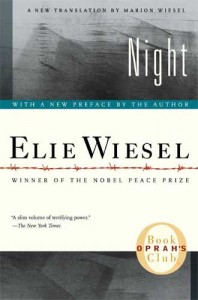
What are we to make of the words “fairly close resemblance?” According to Waltzer—and to Wiesel—Wiesel is writing down his own experience. “Every word is true!” Wiesel has said of his book Night. Thus it should exactly resemble the actual experience he had. I’m going to examine closely what is written in Night about Buchenwald to see if that is the case.
It’s not too difficult because the newest English edition of Night1—a new translation by wife Marion Wiesel which changes (corrects) some of the more blatant “boo-boos” found in the original 1960 edition—comprises only 115 pages. Of that, Wiesel’s description of his time at Buchenwald begins on page 104, giving it only 11 pages (one page being blank).
Wiesel wrote a new preface for this new translation in which he tries to answer some of the more common criticisms of his book. His answer to the differences between the Yiddish And the World Remained Silent and Night is that he cut passages he thought might be superfluous … or “too personal, too private, perhaps.” Strange thing to say since he had already published it. Concerning Buchenwald, he quotes the original writing about the death of his father, where the club-wielder is called “an SS” three times! In Night, as you will see below, this person becomes simply “an officer.” Naturally I ask: Did this scene even happen? Wiesel also tries to explain why he cut out from the ending so much of what was in the Yiddish version, but in doing so he leaves unmentioned an extensive part of what he cut. I have quoted these two endings in Shadowy Origins of Night, Part II.
Wiesel begins his experience at Buchenwald by writing that upon reaching the entrance to the Buchenwald camp along with his father and all the new arrivals from his transport, the SS counted them and they were directed to the Appelplatz (roll call area inside the camp) where loudspeakers ordered “Form ranks of fives! Groups of one hundred! Five steps forward!” He then writes, “A veteran of Buchenwald (as he puts it), told us that we would be taking a shower and afterward be sent to different blocks.” He makes it sound as if it were one of those among them, but it actually had to be a Kapo.
He writes that hundreds of prisoners crowded the shower area and made it difficult to get in, therefore his father wanted to find a place to sit down and wait—which he did in a pile of snow where there were other ‘bodies’ sticking out. Dead or alive we’re not told. It’s one of those literary scenes wherein Eliezer confronts Death via his fear of his father’s death. He writes: “This discussion (with his father) continued for some time.” Then … “sirens began to wail … lights went out … guards chased us toward the blocks.” They obviously did not get a hot shower. Wiesel adds: “The cauldrons at the entrance found no takers.” 2
Are we to believe that the kapos, or “veterans of Buchenwald,” allowed non-disinfected, non-showered new arrivals into the barracks, possibly carrying lice and other vermin with them? No way could this have happened. Yet Wiesel writes: “We let ourselves sink into the floor. To sleep was all that mattered.” I guess it was okay because they didn’t get into the beds.
In the morning, having lost track of his father the night before, he went to search for him. What about the regimentation? What about the early morning roll call? Wiesel writes: “I walked for hours without finding him. Then I came to a block where they were distributing black ‘coffee.’ ” 3 He heard his father’s voice asking for some coffee. He brought it to him. “He was lying on the boards,” meaning, I suppose, a bare bunk. Then, “We had been ordered to go outside to allow for cleaning of the blocks (barracks). Only the sick could remain inside. (If that was the case, they were not fumigating.) We stayed outside for five hours. We were given soup. When they allowed us to return to the blocks, I rushed toward my father” … who told Eliezer he had not been given any soup because “they said we would die soon and it would be a waste of food.”
Apparently, he stayed with his father in that barracks, making sure he was fed. Were they allowed to live in whatever barracks they chose? Again, there is no explanation given for this. He then writes that on the third day after their arrival everybody had to go to the showers, even the sick. Having done that (with no description of the process at all), they again had to wait “a long time” outside the barracks while they were being cleaned.
He fills a couple of pages with scenes of watching his father deteriorate amidst all the heartlessness. Then, after a week, a Blockälteste (block warden) told him he couldn’t save his father and he should help himself by eating his father’s rations. Instead, he pretends to be sick so he can stay in the barracks with his father. He doesn’t go to roll call. Now comes the famous passage in which he writes: “In front of the block, the SS were giving orders. An officer passed between the bunks. My father was pleading: “My son, water…I’m burning up…My insides …” The officer shouts at him to be quiet, walks over with a club and hits him “a violent blow to the head.” On that night, January 28, 1945, his father allegedly died.
The main problems with reality in this passage are:
1) The SS is known to have not been active inside the camp; the prisoner-trustees, usually communists, took care of giving the prisoners their orders. So the SS would not be in front of the block giving orders.
2) “An officer” can only be an SS officer. But they never came inside the barracks. Inmates, no matter how much “in charge” they might be, were not called officers. So who was this mysterious “officer” who was inside the barracks? Not SS at all; just part of the fiction and another attempt to assign brutalities to the SS.
Eliezer says he did not weep for his father. He was numb. He was transferred to the children’s block, where he remained with 600 others until April 11. That’s two and a half months, yet he tells us nothing of that time except that he did have an appetite and his only interest was getting an extra ration of soup. On April 5 (he knew the exact date) “we were inside the block, waiting for an SS to come and count us. He was late. Such lateness was unprecedented in the history of Buchenwald.”
Same problem as above: the official story (and Waltzer’s story) tells us that the communist “veterans” had these boys hidden away in the “small camp” where they cared for them, keeping them away from the SS and the camp authorities. We know that the SS did not go inside the blocks. Yet Wiesel writes that they did every day because on this day they were late. Covering for Wiesel, Waltzer writes on his website:
…the 16-year old Wiesel was assigned to a special barracks that was created and maintained by the clandestine underground resistance in the camp as part of a strategy of saving youths. This block, Block 66, was located in the deepest part of the disease-infested little camp, a separate space below the main camp at Buchenwald that was beyond the normal Nazi SS gaze (the local SS officer actively cooperated and conducted appels inside the barracks).
The barracks was overseen by block elder Antonin Kalina, a Czech Communist from Prague, and his deputy, Gustav Schiller, a Polish-Jewish Communist originally from Lvov. Odon Gati, a Communist from Budapest, was stubendienst. Schiller, who appears briefly in “Night,” was a father figure and mentor, especially for the Polish-Jewish boys and many of the Czech-Jewish boys, but he was less liked, and even feared, by Hungarian- and Romanian-Jewish boys, especially religious boys, including Wiesel. He appears in “Night” as a menacing figure, armed with a truncheon.
First, Waltzer mentions the underground. But they did not have the power to hide away the youths who were assigned to the special barracks 66. It was a policy of the Camp Commandant to separate these children to keep them safe, to feed them as well as possible, and they were fully aware of the children’s barrack 66 where they were kept. Thus. there may have been a “local SS officer” assigned to look after Block 66 to make sure everything was being done according to regulations … that is, even to supervise, to some extent, the communist block leaders. The story that it was the communists who “saved these boys from death” is a fiction that was created later, after the liberation of the camp and the formation of the Buchenwald association which was made up of former prisoners of communist persuasion. It was the camp authorities who made the decision to place the “children” away and apart from the adult prisoners, not the underground resistance.
Second, Wiesel writes in Night, “Gustav, the Blockälteste, made it clear with his club” that they had to obey the order to gather in the Appelplatz. Doesn’t this imply that the communist overseers were not necessarily acting as “father-figures” and mentors, but simply as guards? Also note that the kapo Gustav was carrying a club and used it, while earlier it was an “officer” in the barracks who wielded a club against Eliezer’s father. Relative to this, Ferenc Kornfeld reports : “Without exception, the Kapos all had big sticks.” He also said a Kapo armband went with a double food ration. And, “They continually shouted and they hit people on the head and the neck.” Kornfeld wrote about Buchenwald: “There were common criminals, murderers and thieves, in concentration camps too. They were called the “Blockältesters”. They were the “Kapos” (bosses). As they were murderers, they had black triangles on their uniforms. The Kapos hit and slapped all of us.” So much for the idea of Blockälteste’s as mentors.
The abrupt ending of Night
Wiesel claims on pages 114-15 (the last two pages of the book) that on April 5 everyone, even the children, were ordered to gather in the Appelplatz. On the way, some prisoners told them to go back because the Germans planned to shoot them. They turned around and on the way back they learned that “the underground resistance of the camp had made the decision not to abandon the Jews and to prevent their liquidation.” What kind of nonsense is this? Well, it is “the story” which evolved that these communists at Buchenwald finally, on the very last day, fought the Germans. What really happened was the Germans were ready to abandon the camp on the 11th, which they did. Wiesel simply picks up that official fiction of the underground resistance and incorporates it into his narrative. I don’t think the Germans ever intended to evacuate the children and youths.
Apparently, after the 5th, blocks of prisoners were being evacuated to other camps. By April 10, Wiesel writes, “we had not eaten for nearly six days except for a few stalks of grass and some potato peels found on the grounds of the kitchen.” From whom did these potato peels come? Did their communist keepers gather them and bring them to the youths inside the barracks? Did the boys roam around freely and eat grass? At ten o’clock the next morning, he tells us, the SS positioned themselves around the camp and began to herd the remaining inmates toward the Appelplatz. At this point the underground resistance members appeared “from everywhere” with guns and grenades. Eliezer and the other children “remained flat on the floor of the block.” (Therefore they saw nothing.) By noon, the SS had fled and the resistance was in charge. The first American tank arrived at 6 p.m.
Wiesel now wastes no time in concluding the book. He says he became very ill from food poisoning three days later because they “threw themselves on the provisions.” He spent two weeks in the hospital “between life and death.” One day he got up and looked in a mirror and saw only a corpse gazing back at him. This was at the end of April or first of May 1945. Yet he recovered so well that we see a healthy, smiling boy in the picture supposedly taken of him at Ambloy in late 1945 … or is it early or mid 1946?
It’s interesting that Wiesel made such a point later on of maintaining he had vowed in 1945 to wait ten years to write down his experiences. The reasons given, including that his memory would be sharper after ten years, are completely bogus—especially since his book bears little resemblance to the actual camps as we know them to be. The much longer Yiddish version was published in 1955-56. The abridged French version La Nuit in 1958; the English Night in 1960.
Conclusions
I have to say Wiesel doesn’t describe Buchenwald at all. You don’t know anything about Buchenwald from reading Night. You don’t learn much about Eliezer or anyone else. You are given an impression of suffering, without rhyme or reason, so Buchenwald becomes synonymous with suffering, that’s about it. We don’t know what it looks like. We don’t know the name or the physical appearance of any person, not even Gustav carrying a club, who is said elsewhere to have had red hair. Wiesel makes up a story about “an officer” using a club in the barracks when it could only be a kapo (if it was anyone at all). He doesn’t tell us anything about the children in the barracks where he stayed for 2 ½ months. He doesn’t describe the few days after liberation, before he got sick. One did not have to be at Buchenwald to write what he wrote!
Ken Waltzer also writes at his website:
Elie Wiesel has acknowledged the role played by the clandestine underground and political prisoners in saving children and youth at Buchenwald, especially in his autobiography, but he did not attend to this in “Night.” It was not his purpose or focus in that book. Many of his fellow barracks members, however, who are still alive and remember very well their days and nights in Block 66; their relations with Kalina, Schiller and others; and the hope provided to them there, have been helping fill in the story.
You can see a couple of these fellow barracks members here: Scroll down for Excerpts from the “Boys of Buchenwald” discussion panel (7.45 minutes) You can judge for yourself how impressive they are…or not. Neither one mentions Elie Wiesel.
Endnotes:
1. Elie Wiesel, Night, Hill and Wang, New York, 2006, 120 pgs.
2. This can refer to soup or disinfectant being available at the entrance to the barracks. Obviously, Eliezer and his father dawdling by having their long conversation caused them to miss out on both shower and whatever was in the cauldrons. Just another example of the intended vague descriptions permeating this book.
3. In the book, “coffee” is in quotes signifying it wasn’t real coffee. I left off the quote marks in the original writing because of the quote mark signifying the end of the sentence. Poor judgement on my part, but whether it was real coffee or not wasn’t the focus of my attention in this critique. However, the sharp attention of the author of the Scrapbookpages Blog picked up on this and wrote about Wiesel’s failure to know that real coffee was not served in the camps. My apology to “Furtherglory” for misleading him and to my readers also. I have added the quote marks since reading the blog at Scrapbookpages Blog.
17 Comments
Category Featured | Tags: Tags: And the World Remained Silent, Buchenwald, Elie Wiesel, Gustav Schiller, Ken Waltzer, Night,
Social Networks: Facebook, Twitter, Google Bookmarks, del.icio.us, StumbleUpon, Digg, Reddit, Posterous.
Tuesday, July 12th, 2011
By Carolyn Yeager
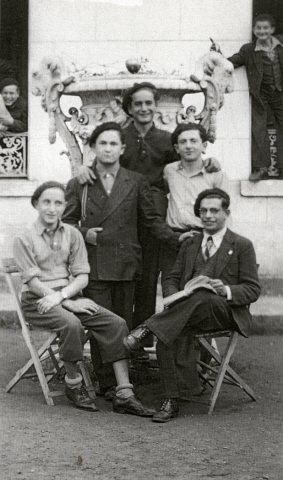
Pictured: front left, Kalman Kalikstein; Binem Wrzonski (middle right), and Elie Wiesel (back center).
This picture is now available for purchase at the USHMM website. The information about it is given as follows:
Date: 1945-1946
Locale: Ambloy (Loir-et-Cher) France
Credit: United States Holocaust Memorial Museum, courtesy of Binem Wrzonski
Copyright: United States Holocaust Memorial Museum
Title: Group portrait of boys in the Ambloy children’s home.
USHMM Commentary: In June 5, 1945, Binem joined a group of boys and young teenagers, known as “The Buchenwald Boys” who were brought to France in a special convey under the sponsorship of the O.S.E. They first were brought to Ecouis in Normandy. An aid worked (sic) helped Binem to make contact with his one surviving sibling, Towa who had spent the war in the Soviet Union. From Ecouis the children were taken to either secular or religious homes. Binem at first wanted to go to a secular home, but Leo Margolis, a German Jew who was in Buchenwald for approximately six years and helped care for the children, persuaded him to go to a religious home. Binem then went to Chateau d’Ambloy. From there he went to Taverny. Then together with two other teenagers, with Elie Wiesel and Kalman Kaliksztajn, he accompanied a group of younger boys to Chez Nous in Versailles where worked as a counselor. From this experience, Binem decided to become a teacher. After training in France, he immigrated to Israel and became the principal of a Youth Aliyah boarding school. In Israel he met and married Rahel Schlezinger and they went on to have five children and many grandchildren and great-grandchildren. In 1983 Binem returned to Lodz and erected a new marker at his father’s graves including the names of all of his family members who died during the Holocaust. [end of USHMM commentary]
* * * *
Binem came from Buchenwald, but not Elie Wiesel and maybe not his good friend Kalman!
What is amazing about this commentary on the picture above is that Elie Wiesel is NOT said to have been at Buchenwald with Binem, but encountered him at Taverny. Elie and Kalman, according to Binem, accompanied a group of younger boys to Chez Nous in Versailles where they worked as counselors. This actually makes a lot more sense. A narrative in which Elie Wiesel is not a withdrawn, scarred youth from the concentration camps, but possibly arrived in France sometime during the war—helped by the Jewish network and placed in the children’s welfare institutions—is quite possible. There, he associated with some of the youths who were sent after the war, and developed his “knowledge” of concentration camp life from them.
Is this why he had no interest in gaining French citizenship—because he was devoted to the Jewish cause of Eretz Israel and always connected to and working with the Jewish Underground? (See Elie Wiesel and the Mossad)
Was Elie Wiesel actually a youth counselor for Buchenwald boys, rather than one of them?
Can this explain why he remained with the welfare agencies for so long and was one of the oldest to leave his last home at Versailles to live on his own? His friend Kalman left for Israel in 1947 before Elie managed to get a room of his own “at the end of summer” at the age of 19. This would have been after his birthday on Sept. 30.
Compare this photograph with the one below, which the USHMM identifies as:
Group portrait of the staff and boys of Ambloy, an OSE home for religious youth.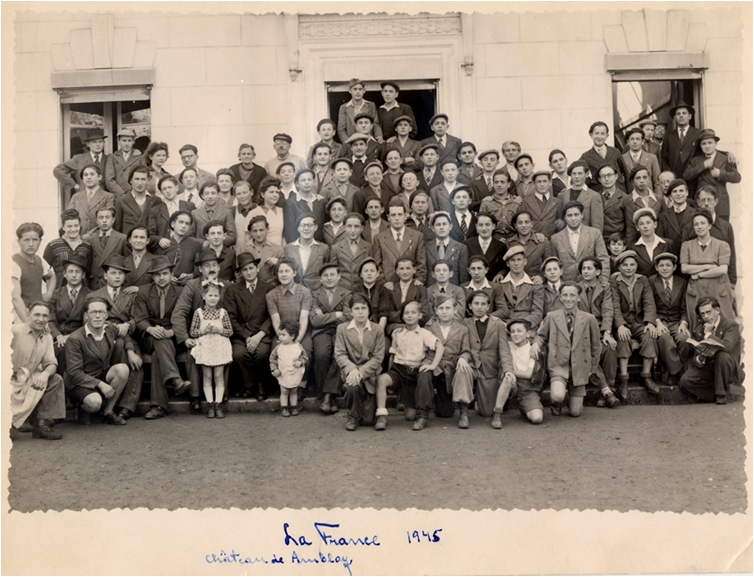
Among those pictured are (First row, left to right): Natan Szwarc, Izio Rosenman, Deblin, unknown and perhaps Berek Rybsztajn. (Third row): Abraham Tuszynsky (2nd from left, first boy next to woman), Andre Zelig is in the center with a tie and his hands on the boy in front of him and Elie Wiesel (second right of Tuszynsky). Binem Wrzonski is to the right of Elie Wiesel. The donor, Jakob Rybsztajn is in the fourth row, fifth from the left.
This picture is available for purchase from USHMM website. The information given about it is as follows:
Date: 1945
Locale: Ambloy, (Loir-et-Cher) France
Credit: United States Holocaust Memorial Museum, courtesy of Jacques Ribons
Copyright: United States Holocaust Memorial Museum
The inscription on the back reads “Before our departure from Chateau Ambloy for Paris.”
USHMM Commentary: Jakob Rybsztajn (now Jacques Ribons) is the son of Peretz Rybsztajn (b. 1905) and Bella (Bajal, b. 1906) Rybsztajn. He was born on August 15, 1927 in Strzemieszyce Poland where his father was a textile manufacturer. He had two younger siblings: Bernard (Berek) who was born in 1929 and Esther who was born in 1935. In 1933 the family moved to Zelow, Bella’s home town. The family remained there until 1936 when it moved back to Strzemieszyce. In 1939 Germany invaded Poland later the Rybsztajns were forced to move to a ghetto. Jakob attended a ghetto Hebrew school. Peretz Rybsztajn, his father, worked with or was close with the Jewish Council but he soon disappeared. After the ghetto was liquidated, probably in June 1943, Jakob and Berek, who initially had hid, were forced to return and then sent briefly to Bedzin. In September they were deported to the Blechhammer concentration camp where they were forced to work unloading cement from train cars, insulating oil and fuel tanks with asbestos, and cementing steel forms to the tanks. They lived in a barrack with other boys their ages, including Kalman and Heniek Kaliksztajn, two brothers also from Strzemieszyce. In January 1945 the Germans liquidated the camp in advance of the Soviet army, and the brothers were sent on a death march via Gross Rosen and by open train to Buchenwald. They arrived in Buchenwald on February 10, 1945, and were placed in the children’s block, Block 66.
Jakob and Berek remained together in block 66 until they were liberated in Buchenwald by the U.S. Third Army in April. The boys in the barrack, under the supervision of Gustav Schiller, the deputy block elder, did not work and received occasional Red Cross packages distributed from other prisoners in the camp. After liberation, the Rybsztajn brothers joined a children’s transport to Ecouis in France, sponsored by the O.S.E., where they were through the summer. But, as they were religious, they were sent from there with other religious boys, including the Kaliksztajn brothers, also Elie Wiesel, to children’s homes in Ambloy and Taverny. Then Jacques came to Paterson New Jersey and later enlisted in US army during the Korean conflict. He arrived in New York in February 1947 on board the Gripsholn, a Swedish ship. Berek was adopted by the Homberger family in California. Later he was in Israel and served in the Israeli Defense Forces; he returned to California in the late 1950s. Jacques also settled in Los Angeles. The Rybsztajn parents, Perez and Bella Rybsztajn, and their sister younger sister Esther perished in Auschwitz, it is believed, during 1943. [end of USHMM commentary]
* * * *
If it can be proven that this is indeed Elie Wiesel in the two pictures, we still do not know if he arrived in Ambloy from Buchenwald.
We have learned that others were there already and the Buchenwald boys joined them. He may have been one of those who were already there. The commentary states as an afterthought that “also Elie Wiesel” was among those sent to Ambloy and Taverny. Where are the records that must have existed? In what capacity was Elie Wiesel there?
The person identified in each photo above as Elie Wiesel is dressed in the same clothing, so the pictures were most likely taken on the same day. The boy Binem may simply have taken off his jacket in the more casual top picture. But where is Kalman in the large group photo? He is not identified and appears to be missing. Rather than pictures on more than one occasion, we have two different pictures taken at the same time.
The group is dressed for travel to Paris (Versailles). It must have been later than 1945 that they transferred to the home in Versailles, so this picture should probably be dated 1946, as is the top picture. All of these questions I raise show the poor scholarship done by the USHMM and the holocaust historians in general. Slip-shod reporting is picked up from here and there, thrown together, becoming the “story” that fits the bill. Thus we have Elie Wiesel’s name stuck in where they want it to be, to try to show that he was one of the Buchenwald boys, when actual proof doesn’t exist.
These photographs only portray someone who could be Elie Wiesel at a home in Ambloy, France where some of the boys from Buchenwald, and also Jewish boys from elsewhere, lived for a time.
As far as the next picture is concerned, I now cannot be sure that these boys are arriving from Buchenwald. They are only identified as Jewish DP (displaced persons) youth at the USHMM website:
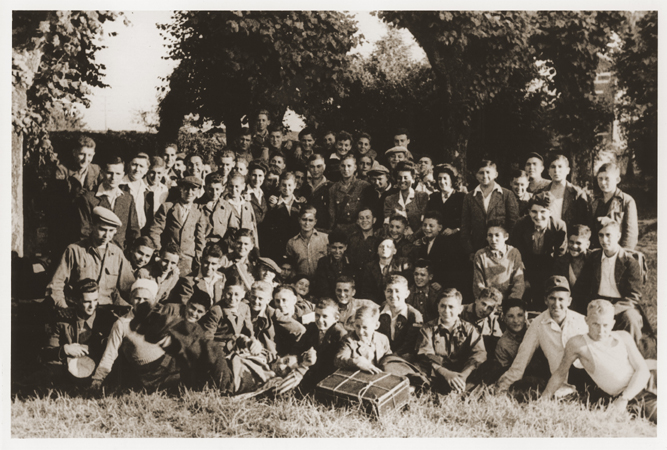
Group portrait of Jewish DP youth at the OSE (Oeuvre de Secours aux Enfants) home for Orthodox Jewish children in Ambloy. Elie Wiesel is among those pictured. [Photograph #28147]
This photo is also available for purchase at USHMM website. The information given about it is as follows:
Date: 1945
Locale: Ambloy, (Loir-et-Cher) France
Credit: United States Holocaust Memorial Museum, courtesy of Robert Waisman. Willy Fogel
Copyright: United States Holocaust Memorial Museum
In this case, none of the boys are identified by name. In the long commentary that accompanies the picture on the page, there is no mention at all of Elie Wiesel. I will say that no one in this picture is wearing a beret! Once again, if the USHMM or Prof. Ken Waltzer claim that Elie Wiesel is in this picture, they must point him out.
It has never been disputed that Elie Wiesel was in France. But just when he arrived and what he was doing there is not documented.
* * * *
The next step for the reader is to compare the face of “Elie Wiesel” in the first two photos above with the faces of “Elie Wiesel” in the famous Buchenwald photo and the boys marching out of the Buchenwald gate, plus his portrait as a 15-year-old, that are found at “The Many Faces of Elie Wiesel.” They can’t all be Elie Wiesel. It’s up to you—and up to USHMM and Ken Waltzer, and how about the old liar Elie Wiesel himself!—to decide and announce which ones are. When that is clear, we can then decide what the pictures are telling us.
10 Comments
Category Featured | Tags: Tags: Ambloy, Binem Wrzonski, Buchenwald, Elie Wiesel, Jacques Ribons, USHMM,
Social Networks: Facebook, Twitter, Google Bookmarks, del.icio.us, StumbleUpon, Digg, Reddit, Posterous.
Thursday, June 30th, 2011
By Carolyn Yeager
(Last edited on July 3 and added to on July 9)
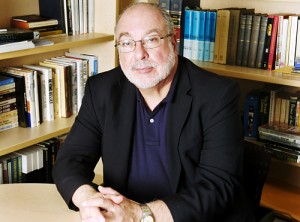 In my previous blog of June 14, I asked the question “What happened to Waltzer’s book about the ‘boys of Buchenwald?’” On June 27, Ken Waltzer (pictured right) answered me … sort of. He said he was not having any trouble with the book, but he didn’t say when we could expect to read it. Not a word on that. But he assured Elie Wiesel Cons the World readers that we will find it a powerful story when we do.
In my previous blog of June 14, I asked the question “What happened to Waltzer’s book about the ‘boys of Buchenwald?’” On June 27, Ken Waltzer (pictured right) answered me … sort of. He said he was not having any trouble with the book, but he didn’t say when we could expect to read it. Not a word on that. But he assured Elie Wiesel Cons the World readers that we will find it a powerful story when we do.
Being a person who likes to stick with the practical and real, I’m not satisfied with Prof. Waltzer’s answer because it avoids the real questions in favor of repeating his claims without supporting them. On top of that, he called me a bigot. This is a grievous fault, it seems to me, in a man who is a Professor of Jewish Studies and German History at Michigan State University. Let’s take a look at what he’s said.
Before writing a comment to my blog, Waltzer first wrote a comment on June 26 to Scrapbookpages Blog. The blogmaster there, who goes by the name of “furtherglory,” had blogged June 16 on my ‘boys of Buchenwald’ article. He checks out new articles about Holocaust on the Internet daily, and seems pretty interested in Elie Wiesel. He added an update to the original blog and asked the question: “Has Ken Waltzer finally figured out that there were three separate people involved in this controversy and all three are named Wiesel.” No, he hasn’t. Waltzer continues to insist that they are all Elie Wiesel.
This is what Ken Waltzer said on Scrapbookpages Blog:
All the ridiculous claims that Wiesel was not Wiesel, Wiesel was not at Buchenwald, Wiesel was a different Wiesel are false, There was one Lazar Wiesel at Buchenwald. He arrived with his father, who appears as Abram, born 1900, and who died shortly after arrival. (He signs his name Shlomo.) Wiesel was then moved to block 66, the children’s block, part of a large child-saving operation by people aligned with the German-Communist led international underground in the camp. He is there with others from Sighet who affirm he is there. He is there until liberation. He is interviewed by American military authorities there. He goes to France.,…
There is no question, indeed there is firm proof, Elie Wiesel was at Buchenwald. And the sections of Night written about Buchenwald are generally accurate and conform to the experience he had.
Comment by Ken Waltzer — June 26, 2011 @ 6:53 am
And this is what Furtherglory said in reply:
Thanks for your comment. A man named Lazar Wiesel was given the tattoo number A-7713 at Auschwitz. A man named Abram Viesel was given the number A-7712 at Auschwitz. Both of them were transferred to Buchenwald in January 1945. Lazar Wiesel, born at Maromarossiget on 4 September 1913, an apprentice locksmith, political detainee and Hungarian Jew, was registered at Buchenwald on 26 January 1945 and assigned the ID number 123565. This must be the man whom you have identified as Elie Wiesel and Abram Viesel is the man that you have identified as Elie’s father. In the records at Auschwitz, Abram Viesel was born on 10 October 1900 at Marmarosz. He was old enough to be Elie Wiesel’s father, but not old enough to be the father of Lazar Wiesel, who was born in 1913, according to the records.
Elie’s full name is Eliezer Wiesel and he was born in Sighet, Romania (Marmarossiget) which was a part of Hungary in 1944. Elie claims he was born on September 30, 1928. Are you saying that his birthdate was mistakenly written as Sept 4, 1913 at Buchenwald?
A man named Lázár Wiesel, (note difference in spelling) born 4 October 1928, was also registered at Buchenwald and given the ID Number 123165. Are you saying that this man did not exist?
You wrote that Elie Wiesel (Lazar Wiesel) was interviewed by the American military. Lázár Wiesel filled out a US Army questionaire on 22 April 1945 at Buchenwald; he stated on the questionaire that he was born at Màromarossziget on 4 October 1928; he was a student who was arrested on 16 April 1944 and interned at Auschwitz and Monowitz. Are you saying that this man didn’t exist?
The records at the Buchenwald Gedenkstätte show that Lázár Wiesel was sent to Paris on 16 July 1945 with a convoy of surviving children and is registered on the transport list. The name Lazar Wiesel is not on the transport list to Paris, which makes sense since he was born in 1913.
Lazar Wiesel’s name was on the transport list from Auschwitz to Buchenwald, but the name Lázár Wiesel was not. That doesn’t mean that Lázár was never at Auschwitz. He could have been sent, from Auschwitz, to some other camp, such as Gross Rosen, and then sent to Buchenwald when Gross Rosen, or whatever other camp, was evacuated.
Comment by furtherglory — June 26, 2011 @ 3:40 pm
It didn’t take furtherglory long to answer Prof. Waltzer and I thought he did a fantastic job. I mean, he’s got it all right and in order and that’s why I’m copying it here … so I won’t have to do it myself. Furtherglory asked Prof. Waltzer some questions, but Waltzer has not yet answered them. I have a feeling he won’t, either, because he doesn’t like to answer questions that he hasn’t posed himself, or are not easy ones. You see, Waltzer spends most of his time talking to his brainwashed students or to Jewish people at Jewish group events, like at the U.S. Holocaust Memorial Museum. Did you know that Jews run that museum and make up most of the attendees at its events? See here. They never ask tough questions.
But still, I was very happy to find a comment on my blog from Prof. Waltzer and I thank him for it. I think it says a lot for him that he is willing to engage, even if only to this extent. He wrote:
by Ken Waltzer On June 27, 2011 at 2:26 pm
Carolyn Yeager suspects that Ken Waltzer is having trouble with his Buchenwald book, esp. proving Elie Wiesel was at Buchenwald as he says he was. Nothing could be further from the truth.
The Buchenwald book is drawn on survivors’ experiences interviewed around the world and on documents from the Red Cross ITS and it will tell a powerful story of endurance and rescue inside Buchenwald.
And related to that larger story, in which Elie Wiesel is merely one of many boys who were helped and saved inside Buchenwald, there simply is no mystery whatsoever of Elie Wiesel, as Yeager claims. He arrived from Buna on a terrible transport on Jan. 26, 1945, with many others (including Miklos Gruner); he was accompanied by his father, who was recorded as Abram (but who signed his name as Shlomo); they were initially together in a barrack in the little camp, 59, I think, and then — after his father died — Elie Wiesel was moved in early February to block 66, the kinderblock. Miklos Gruner too was in block 66. Elie Wiesel was there with other boys from Sighet, who knew him; he was interviewed by military authorities after liberation, in order to permit departure from the camp; and he went after liberation in early June, 1945, to France, to Ecouis…. one among 425 boys who did so. He appears in subsequent pictures at Ambloy and Taverny where the religious boys were taken after Ecouis….
More important, Elie Wiesel’s commentary in Night bears fairly close resemblance to the actual experiences he had at Buchenwald — as recorded in camp documents.
He is the truth teller — Carolyn Yeager; you are the dealer in false claims and bigoted charges.
I am a bigot for doubting Elie Wiesel. I guess it’s some form of antisemitism to doubt that every word Elie Wiesel says is absolutely true … because he is the truth teller, according to Waltzer. And he, Waltzer, is going to prove it.
I consider what Prof. Waltzer is doing similar to ‘sleight of hand.’ He‘s repeating what he’s been saying all along … with a few convenient omissions (for example, the paper proving it he promised 6 months ago). We are to believe that 1) Eliezer Wiesel was listed as Lazar when he arrived, and then as Lázár Wiesel after liberation, with the wrong birth date both times; 2) his father Shlomo was recorded as Abram, also with the wrong birth date; 3) Shlomo is short for Abram or Abraham, not Solomon; and 4) those crazy, mixed-up Nazis got their records wrong.
Has Waltzer managed to falsify some document to show that the elder Wiesel was also known at times as Abraham? We’ll see. Then there is the problem with the pictures. He hasn’t told us which of these boys arriving at Ecouis in France in 1945 is Elie Wiesel. The USHMM tells us Elie is in this picture but doesn’t say where. Can you find him?

He also didn’t point out to us which of these ‘religious boys’ is Elie Wiesel. He titled it “In France — religious boys, including Elie Wiesel.” But how can we be sure?

What he seems to be doing is moving the attention away from these pictures to others of Elie Wiesel at Ambloy and Taverny. If there are such pictures I have never seen them. Have they been newly created? Why keep them hidden all these many years? (post note: See Comments #1,2 and 3) Does this mean that Waltzer is now declining to say that Wiesel appears in the famous Buchenwald photo (below)?
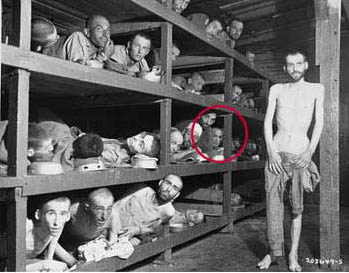
Or in this photo of the boys marching out of Buchenwald after liberation—which he has claimed for several years?
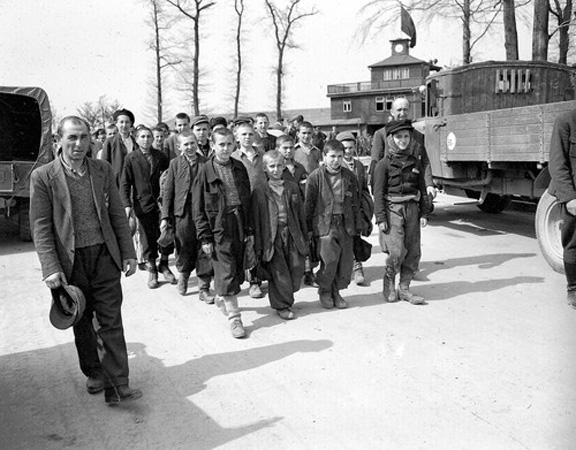
Prof. Waltzer, I know you consider yourself one of the privileged of the world, along with Elie Wiesel, but you must realize that even people of such privilege as yourselves cannot just change Shlomo to Abram as it suits you. When all others who were ‘liberated’ from the German camps are identified by matching their names, birth dates, and prisoner numbers, you cannot decide that in certain cases this formula does not apply and it is YOU who decides who is who.
From your comments, I’m expecting that when your book does finally come out, it will say that Shlomo is Abram and birth dates don’t matter, and this will be a small portion of the book overshadowed by other “powerful” stories of Jewish children. There may be no pictures of Elie Wiesel in France because he is just one of many in your powerful story. It will receive praise, coordinated in advance, from the Jewish media and academic class and no concern whatsoever will be expressed about any contradiction with the facts as they are contained in the Buchenwald archival documents.
But there will be one entity that will not let you alone or off the hook, and that is Elie Wiesel Cons The World website, and maybe some of our readers and followers. So I say—thanks for the comment but we are still waiting and watching for clarification from you.
UPDATE (July 1st):
Shlomo Wiesel was never at Auschwitz or Buchenwald. If he had been at Auschwitz there would be a record for a man named Solomon Viezel or Wiesel born in 1894, who was 50 years old in 1944.
>>We read in Frank N. Magill, ed., “Great Events from History II: Arts And Culture Series: Volume 4, 1955-1969“, Salem Press, Inc., Pasadena, CA., 1993, p. 1700:
“SHLOMO WIESEL (1894-1945), the father of Elie Wiesel“
>>And in in Michaël de Saint Cheron, “Elie Wiesel : L’homme de la mémoire“, Paris, Bayard (coll. Biographie), 1998, p. 25:
“Quant à son père, Shlomo, il ne fut vraiment proche de lui que dans les camps, ces lieux hors du temps, hors de l’espace des vivants, où ils partagèrent le même sort, le même enfer, ou presque.
Son père, né en 1894, à Màrmarossziget, était un juif tolérant et éclairé, alors que sa mère, née en 1898 à Bocsko, cadette de six enfants devenue orpheline de bonne heure, très pieuse, (Translation: His father Shlomo, born in 1894, in Marmarossziget, and his mother, born in 1898 in Bocsko.)
>>More importantly, Elie Wiesel filled out a form for the Yad Vashem Memorial in Israel sometime after the year 2000 (as my memory serves me) stating his father died as a holocaust victim.** On that form, he gave his father’s name as: Shlomo Vizel. He didn’t give a date of birth, but he gave a date of death as Jan. 27, 1945 and the cause of death as: Disease. He signed himself as Eli Vizel, son. That form can be viewed at the Yad Vashem archives online; that’s where I saw it.
Nowhere has Shlomo Vizel (Wiesel) ever been called Abram or Abraham, except now by Ken Waltzer in order to fit with the records for Lazar and Abram Wiesel at Buchenwald.
Stealing real victims and survivors identity is one of the lowest forms of behavior, according to holocaust survivor groups … or so they say. What do you think?
** It should be noted that Elie Wiesel did not fill out Yad Vashem forms for his mother or youngest sister affirming them as victims of the Holocaust. Why not? The logical reason is that he does not have any knowledge that they were indeed taken immediately to a “gas chamber” and killed, as the story has been put out for public comsumption. Even on Wiesel’s main page at Wikipedia it says they were “presumably killed.” That is all. Neither did his two older sisters, who were supposedly at Auschwitz for several months before being transferred to a sub-camp of Dachau, fill out this form for their mother and sister even though they are said to have been all together in the women’s line. These two surviving sisters were totally silent about their WWII experience, in spite of their famous brother, until Hilda, the eldest, gave a videotaped testimony to Steven Spielberg’s Shoah Foundation in the 1990’s.
12 Comments
Category Featured | Tags: Tags: Abram Viesel, Boys from Buchenwald, Carolyn Yeager, Elie Wiesel, Ken Waltzer, Lazar Wiesel, Scrapbookpages Blog, Shlomo Viezel,
Social Networks: Facebook, Twitter, Google Bookmarks, del.icio.us, StumbleUpon, Digg, Reddit, Posterous.
Tuesday, June 14th, 2011
by Carolyn Yeager
MSU Prof. Kenneth Waltzer has been promising his book The Rescue of Children and Youth in Buchenwald since 2007. Four years later, he’s being very quiet about it.
Here is a timeline of announcements about this work in progress, all taken from his Michigan State University website.
May 2005: Professor Waltzer presented a paper, “The Rescue of Children at Buchenwald: Behavior in a Grey Area,” at the Midwest Jewish Studies Scholars Colloquium, Cohn-Haddow Judaic Studies Program, Wayne State University, Detroit.
March 2007: Ken Waltzer will present a paper on “The Kovno Boys: Survival at Auschwitz, Buchenwald, and Mauthaussen,” at the 37th Annual Holocaust Scholars Conference in Cleveland, Ohio.
April 2007: Ken Waltzer presents on his book-in-progress, The Rescue of Children and Youth in Buchenwald, at James Madison College.
May 2008: MSU Professor Ken Waltzer gave the Monna and Otto Weinmann Lecture at the U.S. Holocaust Memorial Museum on the subject of his upcoming book on the rescue operation at Buchenwald that he said saved the lives of hundreds of children and youths.
April 2010: Kenneth Waltzer, professor of history and director of the Jewish studies program at Michigan State University, is currently completing a book about the rescue of children and youths at Buchenwald. [From the April 16, 2010 The Jewish Daily Forward]
The Elie Wiesel Problem
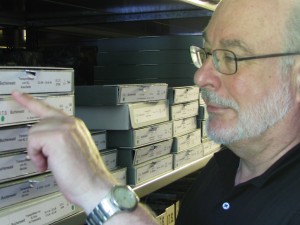 Prof. Waltzer has written and shown pictures of himself (right) doing research at Bad Arolson in Germany, seeking to discover details about the lives and families of the boys of Buchenwald. One of the boys that he may be having trouble with is Elie Wiesel. Waltzer has made a lot of claims and put himself on the line about Wiesel that, in this writer’s opinion, cannot be substantiated.
Prof. Waltzer has written and shown pictures of himself (right) doing research at Bad Arolson in Germany, seeking to discover details about the lives and families of the boys of Buchenwald. One of the boys that he may be having trouble with is Elie Wiesel. Waltzer has made a lot of claims and put himself on the line about Wiesel that, in this writer’s opinion, cannot be substantiated.
For example, last November Waltzer commented on this website to my article “Signatures Prove Lázár Wiesel is not Elie Wiesel” with the following:
Contrary to Carolyn Yeager’s wishful thinking, Eli Wiesel was indeed the Lazar Wiesel who was admitted to Buchenwald on January 26, 1945, who was subsequently shifted to block 66, and who was interviewed by military authorities before being permitted to leave Buchenwald to go with other Buchenwald orphans to France. Furthermore, there is not a shadow of a doubt about this, although the Buchenwald records do erroneously contain — on some pieces — the birth date of 1913 rather than 1928. A forthcoming paper resolves the “riddle of Lazar” and indicates that Miklos Gruner’s Stolen Identity is a set of false charges and attack on Wiesel without any foundation. ~~ by kenwaltzer on November 14, 2010 at 10:34 am
The birthdate on Lazar Wiesel’s records is erroneous—that’s his answer? He is going to “resolve” that? The “forthcoming paper” has not yet appeared 7 months later. His website pages have not been updated for awhile; in fact, they look downright dormant.
Here are the problems I think Waltzer is having, in addition to the birthdate problem:
- He has claimed for at least several years that a picture he has placed on his website of the boys walking out of the Buchenwald front gate shows Elie Wiesel “toward the left.” [See The Many Faces of Elie Wiesel] I say it is not Elie Wiesel, and I don’t know anyone but Waltzer who has identified this boy as Elie Wiesel. This picture is also shown on the USHMM website, and they make no mention of Elie Wiesel as one of the boys.
- In a Power Point presentation that is available on his website, Waltzer shows a group picture of the ‘religious boys’ out of those who went to France, that he says includes Elie Wiesel. I have studied this picture closely and do not see anyone who resembles Wiesel. If Waltzer knows that Elie Wiesel is in the picture, why doesn’t he identify him with an arrow?
Famous Buchenwald Liberation photo is another problem
As I pointed out in “The Many Faces of Elie Wiesel,” the pictures that Waltzer claims contain the face and person of Elie Wiesel do not resemble each other. The famous barracks photo which the New York Times declared to be Elie Wiesel as a 16-year old Buchenwald inmate—and is reproduced all over the world as Elie Wiesel—doesn’t look like the other 16-year old faces.
This writer suspects that Ken Waltzer is having difficulty convincingly incorporating Elie Wiesel into the story of the “boys of Buchenwald” and their rescue. He has been a friend and devotee of Wiesel for many years, they are both strongly associated with the U.S. Holocaust Memorial Museum, and Wiesel has been a part of his Buchenwald story from the beginning. But the real evidence for Elie Wiesel ever being an inmate at Buchenwald doesn’t exist. There are no photographs of Elie Wiesel at Buchenwald; there are no photos of Wiesel during his supposed one-year concentration camp period at all.
I think Waltzer believed this slipshod approach he employs would pass without comment, but he didn’t count on the appearance of Elie Wiesel Cons the World website. We are a real problem for Ken Waltzer!
10 Comments
Category Featured | Tags: Tags: Bad Arolson, Boys from Buchenwald, Elie Wiesel, Kenneth Waltzer, Michigan State University, New York Times, USHMM,
Social Networks: Facebook, Twitter, Google Bookmarks, del.icio.us, StumbleUpon, Digg, Reddit, Posterous.
Wednesday, May 11th, 2011
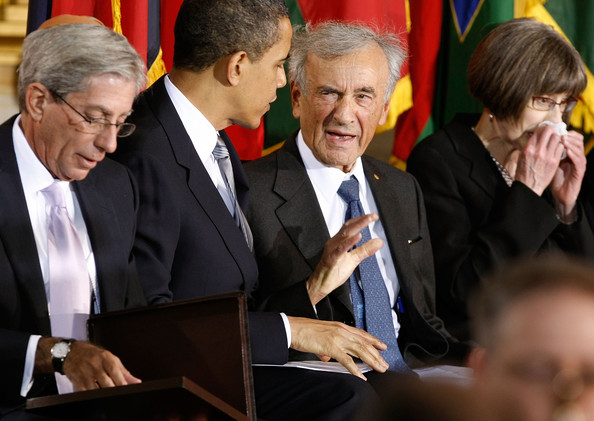
Above: U.S. President Barack Obama with U.S. Holocaust Memorial Council Chairman Fred Zeidman (L), Elie Wiesel (2nd from R) and Holocaust Memorial Museum Director Sara Bloomfield (R) at the “Holocaust Days Of Remembrance” ceremony in the Rotunda of the U.S. Capitol April 23, 2009 in Washington, DC. Established in 1993, the Days of Remembrance are commemorated in April so that they coincide with the observance in Israel. (Photo by Chip Somodevilla/Getty Images)
By Carolyn Yeager
It has just been announced that Elie Wiesel will be the recipient of the FIRST U.S. Holocaust Memorial Museum Award. Not a surprise. Wiesel is the one upon whom the “Holocaust Industry” feels safe in heaping praise, therefore he has enough “distinguished service” type awards to wallpaper a room.
What has he done to actually deserve them? He has been in the service of the outlaw state of Israel for most of his long life, condoning the dispossession of the native Palestinian people, and even their destruction by napalm bombing and massacres carried out on a regular basis. He’s not really a very good liar, although a prolific one, and so his self-created life story is not convincing to a mind that has even a little bit of critical capacity.
If we search earnestly for what this man has actually accomplished, we find a mixture of self-promotion and Holocaust “memory” promotion. In other words, Wiesel is a promoter. He’s made his name synonomous with The Holocaust. Of course, he’s been helped in this by powerful organizations, not least of which is the New York Times Corporation. That is a story that is yet to be told on this website, but it has been well-explored by Prof. David O’Connell in his article “Elie Wiesel and the Catholics.”
Wiesel’s so-called “humanitarian work” has been directed almost exclusively to help Jews and Jewish causes. He makes statements now and then about other groups, such as Africans in Darfur, but mostly ignores all those who are currently in distress in the world today in favor of receiving large sums of money to speak about the Jewish past. He will be doing the same when he receives the award from the USHMM on May 16 – an award that may very well have a sum of money attached to it. Money, by the way, that will be coming from the pockets of U.S. taxpayers!
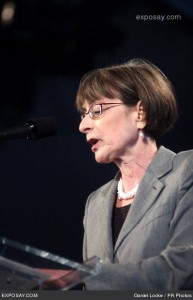 Instead of celebrating this whole hypocritical affair, we should be sickened by it. According to USHMM director Sara Bloomfield, right, (see Bradley Smith’s youtube conversation with Sara), who will present the award, “no one else has done so much (as Wiesel) to honor the victims of the Holocaust by working tirelessly to create a more just world in their memory.” Hmmm. Once again, a more just world for Jews. She explains he does this by his “conviction that the Museum should be a ‘living’ memorial.” She doesn’t explain what makes it ‘living’ and don’t expect her to. These are just words that are designed to stir emotions or good feelings in the hearer, and is what they expect. By such words we are to accept that “His legacy to humanity is unique and extraordinary.” Just don’t ask questions.
Instead of celebrating this whole hypocritical affair, we should be sickened by it. According to USHMM director Sara Bloomfield, right, (see Bradley Smith’s youtube conversation with Sara), who will present the award, “no one else has done so much (as Wiesel) to honor the victims of the Holocaust by working tirelessly to create a more just world in their memory.” Hmmm. Once again, a more just world for Jews. She explains he does this by his “conviction that the Museum should be a ‘living’ memorial.” She doesn’t explain what makes it ‘living’ and don’t expect her to. These are just words that are designed to stir emotions or good feelings in the hearer, and is what they expect. By such words we are to accept that “His legacy to humanity is unique and extraordinary.” Just don’t ask questions.
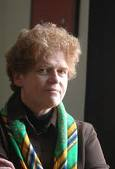 Those lucky enough to attend this dinner will also be able to hear Deborah Lipstadt, left, who will give a speech to promote her new book The Eichmann Trial. In fact, this year of 2011 was picked for the first award because it is the 65th anniversary of the verdicts at the first Nuremberg trial and the 50th anniversary of the trial of Adolf Eichmann. They can’t let “memory” die out, you know. And there is also that need to mark anniversaries of the most sacred dates in the Holocaust religious calendar.
Those lucky enough to attend this dinner will also be able to hear Deborah Lipstadt, left, who will give a speech to promote her new book The Eichmann Trial. In fact, this year of 2011 was picked for the first award because it is the 65th anniversary of the verdicts at the first Nuremberg trial and the 50th anniversary of the trial of Adolf Eichmann. They can’t let “memory” die out, you know. And there is also that need to mark anniversaries of the most sacred dates in the Holocaust religious calendar.
P.S. A postscript to Seven-up: Here is your chance to leaflet a Wiesel event in person. Hop on a plane and get yourself to the Wardman Park Marriott Hotel in Wash. D.C. by May 16th and you’ve got it made. Remember, you can download leaflets questioning Wiesel’s tattoo by clicking on the Downloads button on our menu bar—if you don’t have any leaflets of your own. Good luck and let us know how it went.
9 Comments
Category Featured | Tags: Tags: Barack Obama, Deborah Lipstadt, Elie Wiesel, Sara Bloomfield, United States Holocaust Memorial Museum,
Social Networks: Facebook, Twitter, Google Bookmarks, del.icio.us, StumbleUpon, Digg, Reddit, Posterous.
Sunday, May 1st, 2011
by Carolyn Yeager
Today, May 1st, Elie Wiesel Cons The World received the 17th comment on the blogpost “Is Elie Wiesel a perjurer?” This is the most comments for any article posted here except for our very first “Welcome” blog .
Six ‘believers’ were disturbed enough by this article to write a comment scolding us for it. This tells me that the idea that Elie Wiesel does not have a tattoo, yet says he does, is the most worrisome issue for believers. They get angry when faced with the proof that Elie Wiesel tells lies. They have no way to talk around it.
Realizing this, I am re-posting that article with some added material which I have put in brackets []. This version of the article should be circulated as widely as possible to the mainstream media and mainstream commentators by those of you who want to see some action on this.
Written on August 24, 2010 at 10:01 am, by Carolyn Yeager
Elie Wiesel stated under oath while giving testimony in the trial of Eric Hunt in San Francisco, California in July 2008 that the number A7713 was tattooed on his left arm. (see Where is the Tattoo?)
Wiesel should have been asked to show his tattoo to the court at that time, but he wasn’t. This was a failure of the defense, for sure. But obviously, at that time, Mr. Hunt, the defendant, was not questioning whether Elie Wiesel had been an inmate of Auschwitz-Birkenau.
Since then, Mr. Hunt and others have uncovered video photography of Wiesel’s bare left arm from all angles, leaving no reasonable doubt that no tattoo is there. Backing up this conclusion is the fact that Wiesel has also famously refused to ever show his tattoo when requested to do so. For those who will retaliate that Wiesel may have had the tattoo removed, he said as late as March 25, 2010 that he still had the number A7713 on his arm. (see Where is the Tattoo?) [In September or October 2012, AP reporter Verena Dobnik wrote in a published news report that Elie Wiesel showed her his tattoo during an interview. Wiesel has never denied the story.]
From this, the average man on the street would probably agree that Elie Wiesel has committed perjury (a criminal offense) if he does not indeed have the number tattooed on his arm. The law, according to http://www.lectlaw.com/def2/p032.htm, says:
When a person, having taken an oath before a competent tribunal, officer, or person, in any case in which a law of the U.S. authorizes an oath to be administered, that he will testify, declare, depose, or certify truly, or that any written testimony, declaration, deposition, or certificate by him subscribed, is true, willfully and contrary to such oath states or subscribes any material matter which he does not believe to be true; or in any declaration, certificate, verification, or statement under penalty of perjury, willfully subscribes as true any material matter which he does not believe to be true; (18 USC )
In order for a person to be found guilty of perjury the government must prove: the person testified under oath before [e.g., the grand jury]; at least one particular statement was false; and the person knew at the time the testimony was false.
[Under the law, Elie Wiesel did knowingly lie to the court about a tattoo on his arm.] However, in practice, the question of materiality is crucial. Perjury is defined at www.criminal-law.freeadvice.com as:
the “willful and corrupt taking of a false oath in regard to a material matter in a judicial proceeding.” It is sometimes called “lying under oath;” that is, deliberately telling a lie in a courtroom proceeding after having taken an oath to tell the truth. It is important that the false statement be material to the case at hand—that it could affect the outcome of the case. It is not considered perjury, for example, to lie about your age, unless your age is a key factor in proving the case.
So the question becomes: Was the status of Elie Wiesel as a survivor of at least a seven-month incarceration at Auschwitz-Birkenau in 1944-45, in which case he would certainly have been tattooed on his left arm, as he states himself, material to the guilt or innocence of Eric Hunt in light of the charges that had been brought against him? Certainly, Eric Hunt, not long out of college at the time and who had been assigned to read Night in school, had come to doubt the truth of Wiesel’s assertions and descriptions in the book, and believed that if he could confront Wiesel alone, unguarded, he could convince him to tell the truth.
Does the suspicion that Wiesel necessarily lied in his book Night about what he saw and experienced at Auschwitz-Birkenau because he lied about the existence of a tattoo which he has always claimed as proof of his credentials as an Auschwitz survivor, exonerate Eric Hunt from some of the charges brought against him by the State of California? Is it material to the case? Perhaps not, but it does show cause for Eric Hunt’s desire to speak to Elie Wiesel in an unguarded moment, which was what he was attempting to do.
[I have changed my mind about this materiality issue. Whether Wiesel has a tattoo or doesn’t is very “material” to whether his “protected status” as a holocaust survivior gives him the right to avoid questions by the public, such as Eric Hunt was seeking to ask. Wiesel admits he was not harmed in any way by Hunt, but only frightened for a moment — this hardly warrants a charge of kidnapping against Hunt, or for Hunt to be found guilty of “assault”, and even more, of being guilty of a “hate crime,” which is a felony. Without the “hate crime” attachment, Hunt would not now be burdened with the legal status of felon.
If Elie Wiesel is lying about having a tattoo from Auschwitz on his arm, it is Elie Wiesel who is guilty of spreading hate (against Germans collectively, and yes, against Eric Hunt), and has been doing so since 1960 when his book Night was first published. Eric Hunt was therefore trying to stop the hate by trying to get the truth out of Elie Wiesel.]
If Elie Wiesel cannot be legally found guilty of perjury because of questions of materiality, he will certainly be guilty of perjury in the eyes of the public if he does not produce the famous tattoo A-7713 on his arm—the sooner the better. We are waiting, Mr. Wiesel.
Watch a new, short video on the subject.
Addendum:
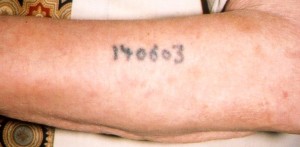
”Auschwitz survivor Sam Rosenzweig displays his identification tattoo.” From Wikipedia According to the information below, this man was in the “regular” series—numbers not preceeded with a letter of the alphabet. Note also that the tattoo is on the outside of the left forearm.
This is the best looking tattoo I could find on the Internet. If you want to have your faith in the Auschwitz Holocaust story badly shaken, google “Auschwitz tattoos” (or any variation thereof) – Images, and see what comes up. Frightening! Of the little that is there, most look like the numbers are way too big, and you find the same few people exhibiting their specimen.
[It should be noted that Auschwitz-Birkenau was the ONLY camp that tattooed its inmates. It was a decision by the camp authorities, not by the SS hierarchy or Adolf Hitler. It probaby came about because of the large number of inmates at Auschwitz-Birkenau-Monowitz and their tendency to give false names and trade places with one another.]
However … George Rosenthal, Trenton, NJ, an Auschwitz Survivor, has written an “authoritative” account at Jewish Virtual Library based on “documents” obtained from The United States Holocaust Memorial Museum. (Sorry, no pictures here either, or on the USHMM website. Elie Wiesel was a major driving force in the creationof the USHMM; why didn’t he volunteer his tattoo to be pictured on their website as an example of what a genuine tattoo looks like? Why does the USHMM have no images of a tattoo?)
Mr. Rosenthal writes:
The sequence according to which serial numbers were issued evolved over time. The numbering scheme was divided into “regular,” AU, Z, EH, A, and B series’. The “regular” series consisted of a consecutive numerical series that was used, in the early phase of the Auschwitz concentration camp, to identify Poles, Jews, and most other prisoners (all male). This series was used from May 1940-January 1945, although the population that it identified evolved over time. Following the introduction of other categories of prisoners into the camp, the numbering scheme became more complex. The “AU” series denoted Soviet prisoners of war, while the “Z” series (with the “Z” standing for the German word for Gypsy, Zigeuner) designated the Romany. These identifying letters preceded the tattooed serial numbers after they were instituted. “EH” designated prisoners that had been sent for “reeducation” (Erziehungshäftlinge).
In May 1944, numbers in the “A” series and the “B” series were first issued to Jewish prisoners, beginning with the men on May 13th and the women on May 16th. The “A” series was to be completed with 20,000; however an error led to the women being numbered to 25,378 before the “B” series was begun. The intention was to work through the entire alphabet with 20,000 numbers being issued in each letter series. In each series, men and women had their own separate numerical series, ostensibly beginning with number 1.
According to this, since there was never a “C” series, the maximum number of prisoners that could have been tattooed after May 1944 was 45,378.
Under “Notes” at the bottom of the page, four books are listed, all by holocaust historians. Are these the “documents” referred to? It also says Source: Center for Holocaust and Genocide Studies at the very bottom of the page, as if referring to the entire page. This Center is located at the University of Minnesota. The affiliated faculty reveals mostly Jewish names.
I report all this because I’m looking for authoritative sources for the exact placement of the tattoos on the left arm, but one doesn’t find that answer even at the Auschwitz-Birkenau Memorial Museum. Why all the uncertainty? Could it be because so many pseudo-survivors have tattooed themselves in unusual ways and places, and the authorities don’t want to nullify their legitimacy?
19 Comments
Category Featured | Tags: Tags: Auschwitz tattoos, Elie Wiesel, Eric Hunt, George Rosenthal, perjury,
Social Networks: Facebook, Twitter, Google Bookmarks, del.icio.us, StumbleUpon, Digg, Reddit, Posterous.
Sunday, April 10th, 2011
by Carolyn Yeager
But you’d never know it from reading the newspapers.
Five months after the original discovery, the Romanian mass grave case seems to have reached closure. In my Nov. 17 blog, I promised you I would keep my eye on this story. Just as I had begun to think it was a dead issue, the news broke.
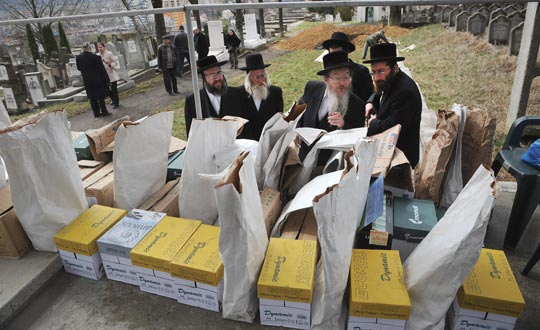
Rabbis from England and the U.S. supervise the boxes and bags containing the remains of 35 to 40 persons removed from a mass grave in Iasi, Romania in Nov. 2010. [photo credit: Daniel Mihailescu]
Jewish rabbis buried the remains of 35 unidentified persons in a single grave in the Jewish cemetery in Iasi, a town in northeastern Romania. The Romanian authorities found 35 sculls in a mass grave, but the spokespersons for the Elie Wiesel National Institute for the Study of the Holocaust in Romania, which claims to have discovered the grave last year, says they can make the number at least 40 because “other remains were found.” Most news reports, however, including Haaretz, Reuters and Vos Iz Neias (an Orthodox Jewish website), reporting from Jewish sources, changed the number to 60, and even implied via confusing language that there were 100 bodies. One hundred was the estimate used by the Wiesel Institute before the grave was fully emptied.
Voice of America writes: “It is not clear how many people are represented by the remains. Estimates range from 40 to 100.
The Reuters article stated: “We gathered here to bury remains of 60 Jews murdered 70 years ago … This moment marks a duty of ours,” Aurel Vainer, head of the Federation of the Jewish Communities in Romania told Reuters.
Vos Iz Neias said: “The memorial, dedicated to about 60 victims unearthed in a forest area near the village of Popricani …” and “Quoting witnesses, the Elie Wiesel institute said more than 100 Jews—men and women, including elderly people, and children—were buried there.”
Haaretz: “The remains of dozens of Jews killed by Romanian troops during World War II have been buried …” and “In November, a Holocaust-era mass grave containing the bodies of an estimated 100 Jews was discovered in a forest …”
I guess these statements could be true if many of the victims were headless. The most accurate coverage we’ve seen comes from The Times of Malta.
Still not confirmed to be Jews
At the time of the discovery, Jewish religious authorities showed up at the site and demanded that Jewish halachic law be followed by not disturbing the bones since they believed they were Jewish bones. However, as I reported previously, the chief prosecutor in Iasi, Cornelia Prisacaru, stated plainly: “We can’t confirm that they are Jews.” And that confirmation has not come. Prisacaru also said at that time: “They could be Russian or German soldiers.” Live WWII munitions were found there in addition to human remains.
The first thing the Romanian authorities did was to close off the area, then unearth all the remains and bring them to laboratories for “forensic testing.” No results have been announced; perhaps something will be forthcoming, or perhaps nothing more can be determined. If the remains had been declared by the prosecutor’s office to be Jewish bones, the Jews would surely have announced that as loudly as possible. Since they have not, we can assume for the time being that it was not determined.
However, the Jews were convinced from the moment of discovery that they are Jewish remains, based on local witness testimony of one or two individuals, and the fact that they say some bodies were clothed in “identifiable Jewish garments.”
There is no word whatsoever from the Romanian prosecutor’s office, except that the boxes and bags of remains were turned over to the official committee of rabbis from England, United States and Romania.
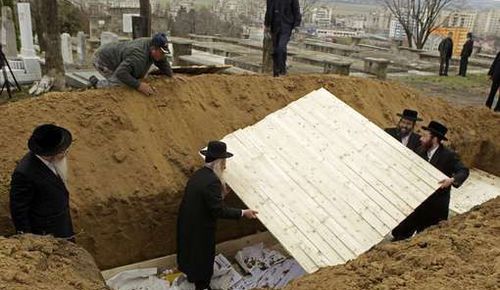
Jewish rabbis preparing the grave to be covered with soil on April 4, 2011. This photo angle gives a good idea of the size of the grave.
Did the Jews win or lose?
The rabbis and Jewish media are putting the best face on it, but they were denied their demand that the bones remain where they were found so that they can build a memorial at the site. They insist these were Holocaust-related deaths which can be blamed on the Romanian Army, allied with the Nazi Party in Germany. The Jews have never failed in the past to persuade national governments to hand over the land where they believe Jews are buried, on which they then build an on-site Holocaust memorial, assuring that the area can never be explored further. This time, however, the Romanians said no, probably because there was:
- No assurance they were Jews
- No assurance they were Holocaust-related
On November 23 last year, The Committee for the Preservation of Jewish Cemeteries in Europe issued a statement in London that “this was the first time ever that a national government is openly declaring its intention to proceed in the disturbance of the graves of Holocaust victims.” All I can say is, it’s about time. Congratulations to the Romanian government.
Thus, the rabbis were forced to bury the remains in a Jewish cemetery nearby. A single large grave was dug to hold all the boxes. Since goyim don’t visit Jewish cemeteries, the propaganda value of the “murdered Jews” is destroyed. But the rabbis did hold a ceremony and made solemn pronouncements with all the dignity of which they are capable.
What if they are not Jews?
The question remains: Since the Jews insisted these were Jewish victims of a pogram, leaving them with no option but to bury them in the Jewish cemetery … what if they’re not Jewish? They may be putting non-Jewish, or what they call Goyim, bones into their Jewish ground and blessing them … a terrible desecration according to their law. I believe they had no choice because image and propaganda is more important to them than their law. Their propaganda insists on Jewish victims, and their image does not allow that they might be wrong.
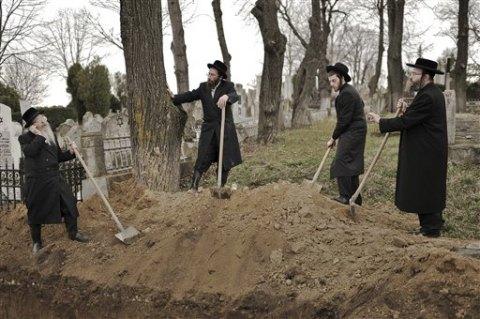
Rabbis take a pause from their labors of filling in the grave after placing the physical remains inside. Do you think they really did it all themselves or is this what is called a “photo opportunity.”
Will this be the last of the Romanian mass grave story? I hope so. But if we hear more about it, we will let you know. The black-eye should go to the Elie Wiesel National Institute for the Study of the Holocaust in Romania for making exaggerated claims in the beginning, which they knew were unfounded. But you just watch—the media, and the local history (based on the Wiesel Institute), will be describing the original grave as holding 60 to 100 bodies, and anyone protesting that number will not be heard. But you can count on always getting the real story here on Elie Wiesel Cons the World website.
See original blog: Wiesel Institute in Romania says it found mass grave of Jews.
11 Comments
Category Featured | Tags: Tags: Cornelia Prisacaru, Elie Wiesel Natl. Inst. for the Study of the Holocaust in Romania, forensic testing, Jewish rabbis, mass grave, Romania,
Social Networks: Facebook, Twitter, Google Bookmarks, del.icio.us, StumbleUpon, Digg, Reddit, Posterous.
Monday, April 4th, 2011
By Carolyn Yeager
Cliches are all Chapman students get from the Master of Platitudes’much-ballyhooed visit.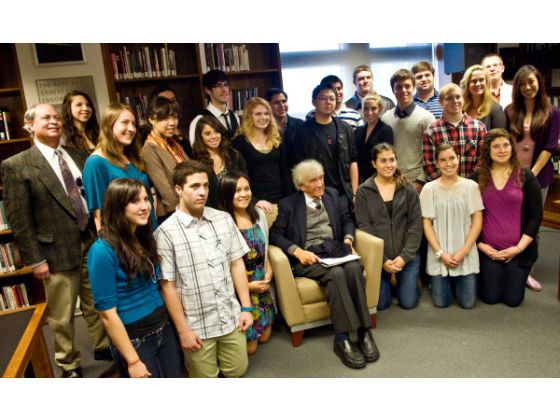 Above: Elie Wiesel looks frail in this group photo taken after he spoke to students at the Sala and Aron Samueli Holocaust Memorial Library at Chapman University. (Photo credit: Orange Country Register)
Above: Elie Wiesel looks frail in this group photo taken after he spoke to students at the Sala and Aron Samueli Holocaust Memorial Library at Chapman University. (Photo credit: Orange Country Register)
The Los Angeles Times sent its own reporter to cover the Holocaust Hero’s grand arrival at Chapman University during the first week of April. The Local section of the newspaper had a report on Wiesel’s visit with 21 students in the specialized Holocaust Library on the campus.
Wiesel has fewer answers these days (not much is expected of him) and speaks in a sort of cliché-language that he has mastered. He can be confident his listeners will supply a profound meaning to any utterance that comes forth from his mouth. For example:
One (student) wanted to know how Wiesel managed to overcome the memories of the deaths of his father, mother and sister to write his first book, “Night,” an autobiographical account of … Nazi concentration camps.
With deep sadness in his eyes, Wiesel replied, “Only those who were there know what it was like. We must bear witness. Silence is not an option.”
Wiesel did not really like this question and gave a short answer that was not an answer at all. The question was: How did he overcome the [painful] memories in order to write his book? His actual answer, interpreted, was: “I won’t, or I can’t, answer your question.” We can ask why he won’t answer that question, and also why he has not ever answered that question. Could it be because he has no idea how to answer it since such a thing did not actually happen to him?
To make it sound like he’s giving some kind of answer, he adds two things that have nothing to do with the question: “We must bear witness” and “Silence is not an option.” These are both favorite sayings typically associated with him. Upon hearing him say them, his listeners are satisfied that they are hearing the real Wiesel, that they are blessed by a “transforming” moment.
Another question was more to Wiesel’s liking. “How can this generation preserve what you learned there?”
Wiesel brightened as he said, “Listen to the survivors. They are an endangered species now. This is the last chance you have to listen to them. I believe with all my heart that whoever listens to a witness becomes a witness. Once we have heard, we must not stand idly by. Indifference to evil makes evil stronger.”
More platitudes. But a reader brought to my attention that Wiesel is contradicting something he said on another occasion. Even though we know contradictions are the usual fare from this man, it’s of note that in a 1978 interview with the New York Times, Wiesel pronounced:
“The Holocaust [is] the ultimate event, the ultimate mystery, never to be comprehended or transmitted. Only those who were there know what it was; the others will never know.”*
This fits his first answer, but not his second. So, is it that “only those who were there know what it was like” (meaning it’s impossible to transmit to others), or is it that we can all “become a witness” (and speak with authority about what it was like)?
If you really want the truthful answer, dear readers, it is whatever benefits the Holocaust Industry. That is the whole reason Elie Wiesel goes to Chapman University—to create publicity for Holocaustianity—since he adds no real value to the students’ learning. Still, it’s all taken very solemnly by the faculty, the mainstream media, and the impoverished students themselves, who don’t realize how they’re being cheated. In a university setting, they are expected to swallow whole whatever they hear from iconic sources re the holocaust. The real questions they have are not answered. It is a farce of education. This Presidential Fellowship shows us once again, when it comes to Elie Wiesel it is always “much ado about nothing.”
*Elie Wiesel, “Trivializing the Holocaust”, New York Times, 16 April 1978, p. 2:1 [Article written in response to the original airing of the NBC miniseries The Holocaust]; quoted in Peter Novick, The Holocaust in American Life, 1999, p. 211.
5 Comments
Category Featured | Tags: Tags: Chapman University, Distinguished Presidential Fellow, Elie Wiesel, Sala and Aron Samueli Holocaust Memorial Library,
Social Networks: Facebook, Twitter, Google Bookmarks, del.icio.us, StumbleUpon, Digg, Reddit, Posterous.
Wednesday, March 30th, 2011
by Carolyn Yeager
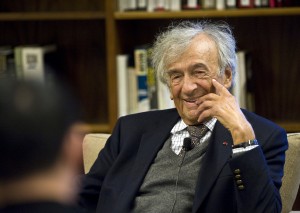 Elie Wiesel arrived at Chapman University in Orange CA on Monday, March 28 in his new capacity as “Distinguished Presidential Fellow” and gave a lecture titled “Knowledge and Ethics.” He also spoke to a small class of Chapman Religion students. According to the Orange County Register [photo at right courtesy Paul Bersbach, OCR], he “answered several questions, but posed many of his own.” This is typically the way Wiesel, 82, avoids revealing his ignorance of the entire topic of the concentration camps.
Elie Wiesel arrived at Chapman University in Orange CA on Monday, March 28 in his new capacity as “Distinguished Presidential Fellow” and gave a lecture titled “Knowledge and Ethics.” He also spoke to a small class of Chapman Religion students. According to the Orange County Register [photo at right courtesy Paul Bersbach, OCR], he “answered several questions, but posed many of his own.” This is typically the way Wiesel, 82, avoids revealing his ignorance of the entire topic of the concentration camps.
Wiesel’s contract with the university, and specifically with the Rodgers Center for Holocaust Education which is the real sponsor and driving force behind the contract, is for five years. Thanks to a bequest from Barry and Phyllis Rodgers, the Rodgers Center was opened in 2000 for the purpose of helping to keep the memory of the holocaust alive, well, and lucrative.
As we reported here last October, each spring semester Wiesel will deliver a lecture and carry on some interaction with students. Don’t think he’s doing it only in the interest of “keeping memory alive” or for any of the noble reasons suggested by Marilyn Harran, Director of the Rodgers Center and University spokesperson on matters pertaining to Wiesel’s fellowship.
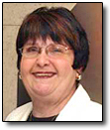
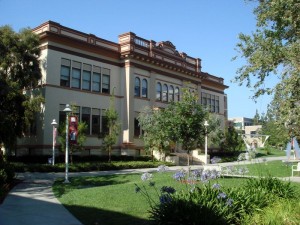
Left: Marilyn Harran. Right: Wilkinson Hall on the Chapman campus. The Rodger Center comes under the aegis of the Wilkinson College of Humanities and Social Studies.
As reported in the Chapman Panther newspaper on March 28, “Harran declined to say how much the Rodgers Center is paying Wiesel for his lecture. Mary Platt, director of communications and media relations, confirmed that the amount is confidential.”
It’s widely quoted that Wiesel’s standard speaking fee is $25,000. We don’t know how much he is charging for visiting with students in their classrooms, but it is no doubt substantial. Chapman’s wealthy Jewish donors who support activities at the special Rodgers Center for Holocaust Education and the Samueli Holocaust Memorial Library are apparently willing to pay it.
Harran, a professor in both the Religious Studies and History departments, is a devotee of Wiesel and his myth. She tends to speak of Wiesel in worshipful terms, as I reported in my Oct. 2010 blog post. At that time, she included these words in her announcement of his fellowship at Chapman: “We are unbelievably fortunate that he has chosen to return to Chapman and to share with us his knowledge and wisdom. I am stunned and deeply grateful that he will be with us in this new role as Distinguished Presidential Fellow. I know our university community will be profoundly enriched and inspired by his presence.” This is the cue for students to show the proper respect toward the visiting professor, and hang on his every word.
Harran is teaching a course this semester called “Elie Wiesel: His Life and Work” with Jan Osborn, professor of English. According to The Panther, only eighteen students are taking the course. Harran wrote a March 28th opinion piece for the school newspaper titled “Knowledge, ethics and Elie Wiesel” in which she mentioned his book Night and also said: “Some of you will recall seeing Wiesel visiting Auschwitz with Oprah Winfrey or standing by President Obama’s side at a commemorative ceremony in Buchenwald. These are powerful images. Indeed, it is hard to remember when the memory of the Holocaust did not have a place in our American life and culture. There are Holocaust documentaries and films; Holocaust museums in cities such as Chicago, Houston and Los Angeles, and the Sala and Aron Samueli Holocaust Memorial Library at Chapman. And there is the United States Holocaust Memorial Museum in Washington, D.C.”
Hurrah, hurrah. Isn’t it wonderful. She gives Wiesel much of the credit for bringing this about. She then asserts this historical tidbit: “the Final Solution was agreed upon in a 90-minute meeting attended by 15 senior SS officials and bureaucrats”—referring to the reputed “Wannsee Conference” in 1942 in Germany. But the meeting minutes show clearly that it was a discussion of the “final solution of the Jewish problem” as a deportation plan, not an extermination plan. So where does that leave Elie Wiesel’s story? And Harran is a PhD in History? It’s obvious she needs some help with knowledge and ethics herself.
Wiesel told the religion students that he studied literature at the Sorbonne University in France before he became a journalist for the Israeli paper Yediot Arhronot in Dec. 1949. I have shown in Questions on Elie Wiesel and the Sorbonne that that claim is false. Wiesel also told the students he cannot answer the questions: Why did the Holocaust happen? and Why did it happen to the Jews? But … “since I have survived, I feel I have a duty to do something with myself.”
In all their discussions of ethics, the pressing current persecution and torture of the Palestinians by Israel is never brought up. EWCTW will continue to report to you about Wiesel’s activities at Chapman. Contributions sent by readers are welcome.
* * *
Also see: Beyond Sensationalism: Writer Discusses Holocaust Literature. Ruth Franklin is on the book circuit trying to explain why holocaust memoirs are so full of fiction.
“From the very moment, it is imagination at work,” explained the writer. “There’s this myth that Holocaust texts emerged fully-formed from their creators. However, so much rewriting was done to tell the story in a more effective, memorable way.” Uh huh. sure.
2 Comments
Category Featured | Tags: Tags: Chapman University, Distinguished Presidential Fellow, Marilyn Harran, Rodgers Center for Holocaust Education, Ruth Franklin, Sorbonne,
Social Networks: Facebook, Twitter, Google Bookmarks, del.icio.us, StumbleUpon, Digg, Reddit, Posterous.
Tuesday, March 22nd, 2011
By Carolyn Yeager
copyright 2011 carolyn yeager
Déjà vu. Elie Wiesel becomes an American but his ties to Israel and manner of life don’t change.
Arriving in New York in 1956, Wiesel is greeted and assisted by “Israeli colleagues” who accompanied him and “served as real-estate advisors.”14 Everywhere Wiesel goes there are Israelis on hand to help; he is never alone or “on his own” and we must conclude that he never has been. Some of his named associates at the time are David Gedailovitch, a.k.a. David Guy, a perfume merchant and restaurateur; Jacob Baal-Teshuva, an Israeli Film weekly rep; Richard Yaffe, correspondent for an Israeli daily who had been subpoenaed by the House Committee on Un-American Activities. Wiesel hangs out with Jews, of which there were no lack in New York, and seems only comfortable with members of his own Tribe—even more so if they are fellow Zionists, which most seem to be. The French Catholic François Mauriac appears as the sole exception, but that relationship existed purely for career advancement.
Wiesel says he loved covering the United Nations, where he spoke most often with Abba Eban, Israel’s “young ambassador.” [Rivers, p 290] But, as he always does, he tells us that he wasn’t paid a living wage and had to “alleviate [his] financial problems” with free-lance work. Also, as so often happens, an unnamed benefactor shows up–an “editor” who told him he had no money for news reports, but did have a budget for a novel. Wiesel replied, “I may have something stuck in a drawer somewhere.”
Wiesel writes his first novel
I sat at the typewriter that very night, and in a week or two I churned out (under the pseudonym Elisha Carmeli) a romantic spy novel of which I remember only the premise: A man and a woman, both Israeli intelligence agents, are desperately in love, and one or the other is sent on a mission to Egypt. I can’t recall if the operation was a success, but I do know that all my characters died at the end, since I wasn’t sure what else to do with them. [p. 291]
Déjà vu, indeed. Under pressure, Wiesel churns out in “a week or two”—just as he did on the ocean liner to Brazil less than two years previous15—a spy novel? In this instance, we have to assume he was still working at his regular job, so the fact that it was a shorter book should not be held against him. But, here are my questions: How does he explain that as a religious, idealistic young man, he knew how to weave together a believable story about Israeli spies? Why did he even choose the subject of spies, rather than a simple romance between displaced persons, or immigrants to Israel—something he had seen close up, and even experienced? I know enough about writing to know that when one has to write something in a hurry, one will always choose the most familiar theme. Otherwise too much research is required; without it, mistakes will certainly occur.
Though this is a small detail tucked into Wiesel’s memoir, I think it speaks volumes about that with which Wiesel was actually familiar.
The “editor” published the book under the title, Silent Heroes.16. Wiesel says he never read the book, but Simon Weber, news editor of the Jewish Daily Forward, noticed it and, based on it, offered Wiesel a job with his newspaper. Wiesel describes the Forward as “the world’s biggest, richest, and most widely read Yiddish daily.” [p. 291] It must have been some book! Weber didn’t hire Wiesel because of his great journalism, but because of a silly spy novel, quickly thrown together. This makes no sense except as another typical Wieselism. Wiesel obviously had connections and assistance at high levels, but he wants us to believe in the holocaust victims’ luck and miracles. Or maybe it’s that he is himself so immersed in lies that he’s incapable of telling the truth about anything. In that regard, we now come to the Big One.
Wiesel gets hit by a taxi and flies through the air to land a full block away
On a summer evening in 1956, Wiesel was crossing Seventh Avenue at Forty-fifth Street with a woman from his office when he was hit by a taxi.
The impact hurled me through the air like a figure in a Chagall painting, all the way to Forty-fourth Street, where I lay for twenty minutes until an ambulance came to take me to the hospital. […] My entire left side had been shattered. A ten-hour operation was required to reconstruct it, leaving me in a cast from neck to foot. […] One morning I was visited by a lawyer who said he represented an insurance company. He had a proposition for me: If I signed a certain document, a simple piece of paper, he would hand me a quarter of a million dollars on the spot. […] I was ready to sign that document and any others in his bulging briefcase. But my journalist friend Alexander Zauber screamed, “Are you crazy? Don’t sign anything!” […] You really want to let this crook ruin us? Tell him to get the hell out of here! I’ll get you a lawyer who defends victims instead of swindling them. You’re going to be a millionaire, I guarantee it!” [p.293-95]
Zauber showed the insurance emissary to the door. But Wiesel was worried about paying his current bills, mostly because he was about to be moved into a double room, for him “a terrifying prospect. Ever since the war the idea of sleeping in the same room with a stranger had panicked me.” With the immediate insurance money, he could remain in a private room. Therefore, he decided to call the insurance agent back that night, after Zauber had gone. [p.296]. But again, help arrived from the Irgun …
I had forgotten to allow for the possibility of a miracle. Among my visitors that day was Hillel Kook, who asked Aviva and other friends to leave us alone. He was an unusual man, the archetypal Central European intellectual in demeanor and looks; nearsighted, thin, tense, and curious. I had interviewed him several weeks earlier. He had just founded a political organization to combat Soviet interference in the Middle East. I knew him by reputation only. A member of the Irgun high command under the alias Peter Bergson, he and the writer Ben Hecht had directed the Committee of Hebrew National Liberation during the war. Their main objective was to save European Jews. In fact, no one had done more than Bergson to alert the American public to the tragedy of the Jews under the Nazis. Consequently, he was thoroughly disliked by the American Jewish establishment, which consistently fought and slandered him. During the Altalena affair he was even imprisoned by Ben-Gurion. “I heard what happened to you,” he said, coming straight to the point. “As you’ve probably discovered by now, being sick in New York costs money. You don’t have any, but I do. So I brought you a few blank checks. Fill them out as the need arises, and let me know when you need more.” Hillel’s manner was matter-of-fact, as though he made gestures like this every day. [p.296]
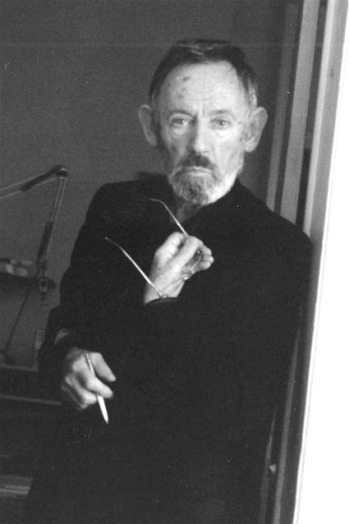
Right: Hillel Kook, a.k.a. “Peter Bergson,” member of the Irgun High Command was another of Wiesel’s Angels of Mercy. He worked in America as an undercover agent, then made a considerable fortune on Wall Street in the 1950s and 60s. 17
I was so overcome by his generosity that I was unable to utter a word. I gaped at him as though he were a tzaddik or an emissary of the Prophet Elijah, most unpredictable of prophets. Finally I managed to ask him how I would ever repay him. “Don’t worry,” he replied, as nonchalant as a banker addressing a colleague. “I have plenty to live on. You can pay me back when the insurance company pays you off.”
When Aviva and the others came back in, I told them of the miracle. Zauber cried, “It’s a sign from God. He wants you to listen to me. Don’t be a fool. Now you can stay in your own room and you can hire my lawyer.” “You’re going to be a millionaire,” he said. “My friend the millionaire. I warn you, if you sabotage my plans, I’ll kill you. And my lawyer will defend me.”
Every week, Hillel called to find out if I needed more checks. In the meantime, the lawyer filed the suit that he and Zauber assured me would change my life for good. I made statements, signed documents and depositions. A month, a year went by. I returned to my hotel. Zauber returned to Israel, Bea to Montreal. From time to time I asked the lawyer how things were going. He was a patient man, and he advised me to follow his example. Eighteen months after the accident he accompanied me to court. This was not yet the trial, but a simple procedural matter. Two years after the accident, there was still nothing. One day Hillel called me, and we had coffee together. He asked me about the trial. Wall Street, it seems, had not been kind to him, and he was short of cash. But not to worry, he would work it out. He would wait. That day I instructed my lawyer to settle the matter within the week. He tried to talk me out of it. […] The next day he informed me of the result of his negotiations: He would receive 30 percent of my payment and from the rest Hillel would be paid back.
That’s how I failed to become a millionaire. [p. 297]
The prodigal visits his hometown Sighet
In 1960, Wiesel’s book Night was published in English, but was slow to catch hold. In 1961 the Adolf Eichmann trial in Jerusalem was the object of his attention and journalism, which he covered for the Forward. In 1964, at the age of 35, he [or his handlers] decided the time was right for a trip to Sighet, his alleged hometown, via Budapest, Bucharest and Baia-Maire. [p. 357]
In Budapest I visited the Jewish quarter, seeing traces of its past. […] When I finally did return to Sighet, the cemetery was the first place I wanted to visit, to meditate at my grandfather’s grave. As is customary, I would have to light candles. I found a store and bought two candles. So it was that I had the feeling I was following a scenario written by someone who existed only in my imagination. Michael 18 was my precursor, my scout. I followed his every step. I saw through his eyes, felt what he felt as I wandered the streets among passersby who didn’t recognize me or even glance at me, and as I entered my home, a stranger in my own house. [p. 357-8]
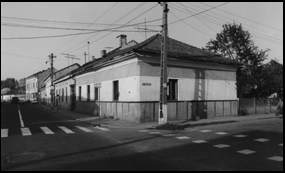
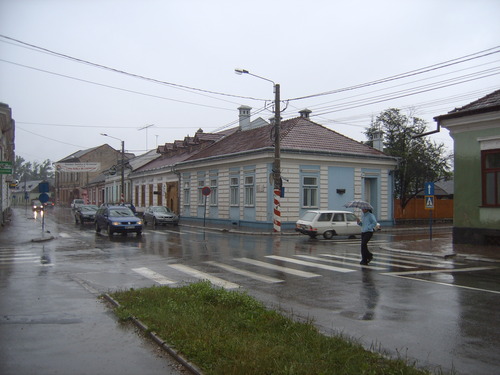
Above left: Photo of the house where Elie Wiesel allegedly grew up in Sighet, Rumania. Above right: The same house in 2007 after remodeling. Is the blue and white paint in honor of Israel? His parents are said to have run a grocery store on the premises, but we can see no evidence of that in the pictures.
We should not be surprised that Wiesel again experiences his early life as if he were a character in his own fictional writing. In Night, supposedly the “true” account of his time at Auschwitz and Buchenwald [“every word is true”], he was Eliezer, the 13-year-old boy [not 15 as he was in real life] who saw flames shooting from the crematory chimney as he disembarked from the train at midnight, followed by a burning pit of fire in which babies were being thrown. Now, he becomes “Michael,” from another of his novels, as he “wanders” through Sighet. Was it so unfamiliar because he had never really lived there, just as he was never really in Auschwitz or Buchenwald?
Further, we can ask: How did he “enter his home?” Was it empty? Did he ask the current residents for permission? Those answers not being given, it remains left to our imagination.
Though it hadn’t changed, I found it hard to orient myself in the little town. It seemed not to have endured a war. The streets were teeming with people. The park was as it had been, the trees and benches still in place. Everything was there. As before. Everything except the Jews. I looked all over for them, looked for the children
[…]
I roamed the streets, stopped at the movie house, went to the hospital. No one paid attention to the prodigal returning home from afar. It was not only as though I didn’t exist, but as though I had never existed. Had there really been a time when Jews lived here? 19 [p.358]
[…]
I continued my rediscovery of Sighet. Walking down the Street of Jews—almost every town in Eastern Europe had one—I saw nothing but sealed shutters and doors nailed closed. All […] now stood empty. It struck me how poor they had been, those Jews of Sighet so dear to me. That was true of all of us, though as a child I had been unaware of the poverty that prevailed in the Jewish neighborhoods. 20
[…]
I set out to see the synagogues again. Most were closed. In one I found hundreds of holy books covered with dust. The authorities had taken them from abandoned homes and stored them here. In a frenzy, I began to look through them. I was rewarded when I discovered a few that had belonged to me. I even found some yellowed, withered sheets of paper in a book of Bible 21 commentaries: a commentary on the commentaries I had written at the age of thirteen or fourteen. The handwriting was clumsy, the thoughts confused. [p.359-60]
Which “authorities” is he referring to: Jewish or Hungarian? Would the Hungarian police have bothered to take books out of the homes and store them? And what are the odds that he could look through “hundreds of books” in the time he had and find some of his own in the piles? Or that his would be stored at one of the few still-open synagogues in Sighet and his commentaries were still in them? He falls back on his previously used artifice that it was possible because he did it “in a frenzy.” As he typed 862 pages of a difficult manuscript in two weeks max in 1954—in a frenzy, so now he does another impossible task in a frenzy. Further, has anyone ever seen these handwritten commentaries? Would he have left them there? They would offer proof that he actually lived in that town.
Previously I wrote about the question of Wiesel’s typing ability. He has written that he sometimes went as a youth to the synagogue ‘office’ where he used the only typewriter available in the community to type up his religious commentaries. But now he writes that those he found were handwritten. He has also made it clear that all his adult writing has been done in longhand, not typewritten. This is unusual for someone with a long career as a journalist.
A mission to bring Soviet Jews to Israel
In 1965, Wiesel made an “unexpected journey to the Soviet Union.” It may have been unexpected because the Israeli Ministry of Foreign Affairs requested that he go, but he was carefully prepared for it.
Meir Rosenne and Ephraim Tari, two of the most effective and devoted young diplomats in the Israeli Ministry of Foreign Affairs, prepared me. Both spoke French, were interested in literature, and, as it turned out, belonged to a semiofficial government office reporting directly to the prime minister. Meir in New York and Ephraim in Paris oversaw clandestine activities on behalf of Soviet Jews. It was an arduous task, more dangerous than it appeared. Arduous because even the largest and most influential Jewish communities refused to become actively involved. They were delighted to aid Israel, but the desperate Jews behind the Iron Curtain were both distant and invisible. Nobody seemed to know what concrete action Soviet Jews really wanted Jews in the West to take for them. [p.365]
[…]
How many were they? There was talk of millions, but that figure seemed implausibly high. “You ought to go and see,” both Israelis told me. “You have been a witness before, now you must go and find out the Soviet Jews’ true situation and testify for them.” […] I was briefed by experts. [p.366]
Why was Wiesel the choice of the Israelis who reported directly to the prime minister about clandestine activities regarding Jews in the Soviet Union? Was he famous in 1965? Was he the High Priest of the Holocaust at that time? No, that was still to come. But he was a Mossad agent, and on their payroll, at least as a retainer. Wiesel seems up to now to have been involved when immigration of Jews to Israel—legal or illegal—was concerned, and to bolster the feelings of Jewishness of those in the diaspora. This trip appears to follow in that vein. Communist Jews were perfectly acceptable, as dark-skinned Morrocan and Ethiopian Jews were earlier. The idea was to fill up Israel with Jews in order to keep claiming more of the physical territory of Palestine.
I left for Moscow in time for the High Holidays, then went on to Leningrad, Kiev, and Tbilisi. I returned transformed […] I immediately felt close to these forgotten, tenacious Jews. … Having survived the massacres of the Nazi era and the Stalinist persecutions, they proclaimed their Jewishness even in the heart of the Gulag and the cellars of the NKVD and KGB. [p.366]
[…]
We were determined to help the Jews left behind the Iron Curtain, even if we had to defy the Kremlin and all its police. We had been privileged to make the surprising discovery that with a number of notorious exceptions, even Communist Jews had remained Jewish. [p.369]
Notice the “we.” He was working with others on behalf of Zionism and its goals, not on his own. Wiesel can find good things to say about all Jews, no matter how much blood is on their hands—for example, Zinoviev and Ehrenburg.
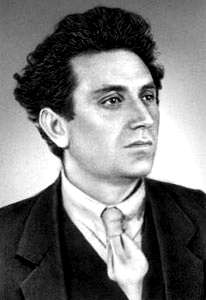
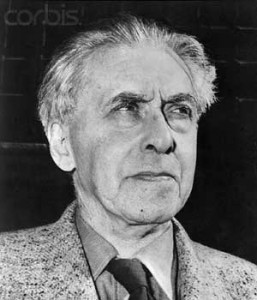
Left: Grigory Zinoviev, a.k.a. Apfelbaum, born Radomysisky in Russia, died 1936, was a close associate of Lenin. Right: Ilya Ehrenburg, a leader of the hate campaign against Germans during WWII, author of the article “Kill” which appeared in 1942. His support for Stalin never wavered.
A journalist friend told me that Zinoviev—Lenin’s companion and ill-fated admirer/adversary of Stalin—faced execution with the Shma Yisrael on his lips. All his life he had clung to his atheism. For a Jew to be a Communist meant repudiating his or her Jewish faith, Jewish tradition, Jewish history.22 And so many became resigned to integration, assimilation, and mixed marriages—anything to ensure that their children would no longer be tied to the Jewish people or to Jewish destiny. And yet …
Ilya Ehrenburg was an example. During the last years of the war, along with Vasily Grossman (author of the brilliant Life and Fate), he scoured cities and villages, gathering chronicles and testimony from survivors of the ghettos and the camps. Together they compiled an anthology of human cruelty and Jewish suffering reaching from Vilna to Minsk, Berdichev to Kiev, Kharkov to Odessa. This “black book” contained accounts one cannot read without feeling despair. It was not published because by 1945 Stalin had changed his policy toward both Germany and the Jews. The Kremlin’s spokesmen and propagandists received orders to no longer emphasize German atrocities or the calvary of their Jewish victims. […] It was he [Ehrenburg] who had entrusted a copy of the manuscript to a reliable friend who was to convey it to Jerusalem when the chance arose. Novelist, pamphleteer, propagandist, and Communist, if not Stalinist, Ehrenburg nevertheless had remained a Jew at heart. [p.369]
Ehrenburg, the murderer of millions of Russians and Germans, is hailed as a True Jew by Elie Wiesel! This is the true Wiesel, who will forgive any Jew as long as he professes himself a Jew and proves loyal to Jewry. He celebrates this recognized monster, releasing him of all his sins because he compiled a book of Soviet lies about “Nazi atrocities” and the sufferings of Jews. Stalin changed his policy in 1945 because Germany was no longer a threat to him, but the Jews were, just as they had been to Germany before, and before that to Czarist Russia. This is a low point in Wiesel’s memoir, but he is trapped in his own ideology and complete insensitivity to any but Jews.
A second trip to the USSR
Wiesel made a second trip to the USSR about a year later. Though it was more difficult to get in since he had published about his first trip, still he and a friend, Michel Salomon, managed to return. Once again his high-level connections made it possible. At the airport,
the Israeli charge d’affaires, David Bartov, and his wife, Esther, had come to greet us. [ …] We sped through the city in David’s diplomatic vehicle. Two spacious rooms had been reserved for us at the National Hotel. That very evening the Bartovs took us to a performance by a traveling Yiddish troupe. [p.370]
Don’t they ever get away from Jews? No, they don’t appear to have any desire to. Also, note what priceless benefits statehood has brought to international Jews–they have diplomats with special privileges and immunity, and greatly improved international connections.
On this trip, Wiesel says he was followed by KGB agents, his hotel room was searched while he was out, and the copy he brought along of his newest book on the plight of Russian Jews, The Jews of Silence, was taken. Finally frightened by this, he was back at the airport for a return flight back to Paris, about to board, when …
The young woman motioned to me to board, but at the same instant the officer shouted something. Suddenly things moved quickly. Before I realized what was happening, the two Israelis were at my side. One of them took my ticket while the other snatched my passport out of the officer’s hand. I felt myself being lifted like a package. They ran, and so did I, amid whistles and shouted orders. I don’t know how we managed to jostle our way through all the gates and barriers, but we jumped into the embassy car and took off. Why the police didn’t stop us, I don’t know. I was too stunned to try to understand, too dazed to think about it. The Israeli behind the wheel drove as if he were back home in Tel Aviv. I would worry about that later. In a moment we were on embassy grounds. [p.374]
Wiesel tells about this trip in great detail, taking five pages, which means it probably happened the way he says. Why can he do it in this instance, while other, more important events in his life are sloughed over in a single paragraph? I leave the reader to answer that. After spending three days at the Israel Embassy, things were “straightened out.”
Accompanied by my two Israeli bodyguards, I returned to the airport. Everything went smoothly. The Intourist and Aeroflot employees greeted me amiably. There was no problem […] The plane was half empty. I had the whole first-class section to myself. 23
[…]
I arrived in Paris just in time for the annual conference of French Jewish intellectuals organized by Jean Halperin and Andre Neher under the auspices of the World Jewish Congress. Rather than speak on that year’s designated topic (God and …), I recounted my experiences and impressions while in Moscow. [p375-6]
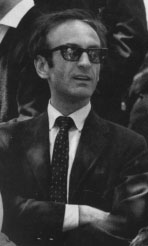
Above: Elie Wiesel at a rally for Soviet Jews in New York after his two trips to the Soviet Union. Wearing dark glasses, he looks the role of the undercover agent.
A couple pages later, we gain some insight into Wiesel’s fanatical and totally Jew-centered world-view when he speaks about the Talmudist Saul Lieberman, with whom he was thrilled to be able to study.
He made me aware that to be a Jew is to place the greatest store in knowledge and loyalty; that it is because he recognizes divine justice that he speaks out against human injustice. That it is because a Jew remains attached to his God that he is permitted to question Him. It is because the prophets loved the people of Israel that they admonished them and reprimanded their kings. Everything depends on where you stand, my master used to say. With God anything can be said. Without God nothing is heard. Without God what is said is not said. [p.380]
This explains to some extent to me why they can lie so easily. All Jews are with God, therefore anything can be said. Those without God—goyim, gentiles—are not heard. What they say is not said, means nothing. This is a reasonable interpretation which we see acted out everywhere before our eyes. It makes clear why the Gentile world and the Jewish world cannot adjust to one another. All such talk by Jews that if the Gentiles would just make enough concessions it would be possible, is deceitful. At least it is when dealing with Jews like Elie Wiesel and Saul Lieberman.
The Mossad motto: By way of deception (deceit), thou shalt make war (defeat thine enemies). Elie Wiesel has been shown again and again to be deceitful. Thus, he is perfectly in tune with the Mossad.
Endnotes:
14. Elie Wiesel, Memoirs: All Rivers Run to the Sea, Knopf, 1995, p. 286.
15. Wiesel claims to have written Un di Velt Hot Gesvign, a Yiddish manuscript of 862 pages, while on a boat traveling to Brazil in Spring 1954. See http://www.eliewieseltattoo.com/the-shadowy-origins-of-night
16. Silent Heroes is not ever listed among the books Wiesel authored, nor could I find it at Amazon.
17. http://www.foreignpolicy.com/articles/2010/04/27/pen_portraits_from_a_forgotten_middle_east?page=0,4
18. Michael is the main character in his book The Town Beyond the Wall [1962], a fictional account of his life in Sighet.
19. According to one visitor: In the spring of 1944, more Jews than Gentiles lived in Maramureş, a remote part of Romania then under Hungarian control. Most had come in the late nineteenth and early twentieth centuries from Russia. (They are really Russians, not Hungarians or Romanians.) Some worked the farms, and some lived in villages and towns, working as traders and craftsmen. There were synagogues in most villages, and in the regional capital, Sighet, Jews worshiped at the elaborate synagogue on Nagykoz Street.
20. Yet Wiesel, or his handlers, presents his family as prosperous, progressive, cultured and upstanding. We see pictures of them looking fairly middle-class. Sighet was the capital city of the province. What is the reality?
21. By “Bible” he really means Talmud.
22. This is simply not true, but is Wiesel’s attempt to separate Jews from the Communist taint.
23. We learn from this that Wiesel travels first class. What else would we expect?
4 Comments
Category Featured | Tags: Tags: Daily Forward, Hillel Kook, New York, Saul Lieberman, Sighet, Soviet Jewry,
Social Networks: Facebook, Twitter, Google Bookmarks, del.icio.us, StumbleUpon, Digg, Reddit, Posterous.


























